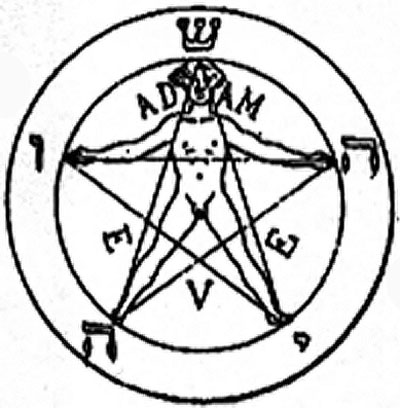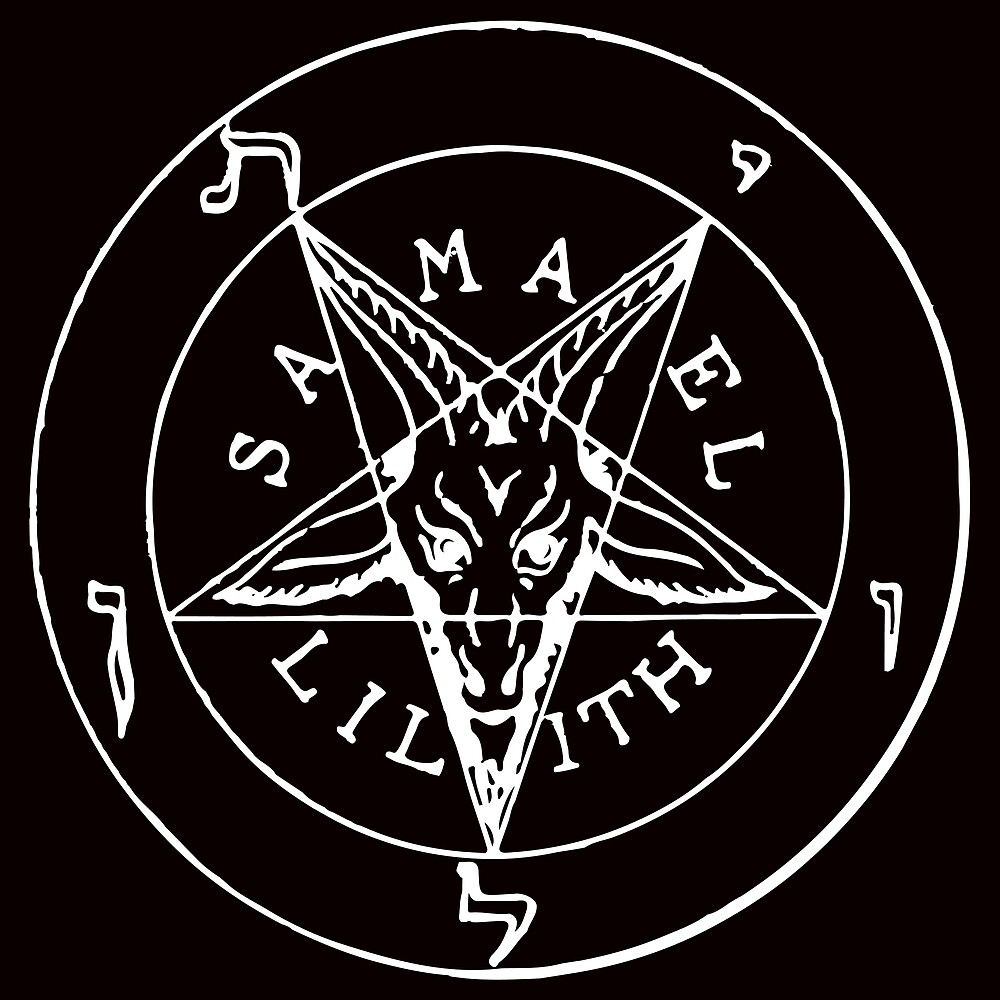A long time ago, I posted this banishing ritual that I made for my own use. I promised then to explain the occult reasoning behind it. I forgot to do that for… more than a year.
So here, at long last, it is: notes on the Lesser Ritual of the Inverted Pentagram.
Some of this explanation is a little esoteric. Since I don’t have the ability to explain all of Kabbalah and its history of appropriation and misappropriation in this post, you’ll need to do that research yourself. Sorry. I made this as simple as I can.
- The Klipotic Inverted Cross
The traditional Golden Dawn Lesser Banishing Ritual of the Pentagram begins with a Cabbalistic Cross.
Since crosses are Christian and Kabbalah is Jewish (it’s often spelt Cabbala when Christianized and Qabbalah when western esotericists get into it) that’s kind of wack already.
This Cabalistic Cross is accompanied by questionable Hebrew that more or less translates to, “For thine is the kingdom, and the power, and the glory forever, amen.”
The points touched on the body while making the cross and saying those words soooort of correspond to sephirot on the Tree of Life. “Atah” corresponds to Keter and the top of the head, “Malkuth” means Kingdom and is linked to the groin (sooooort of), “Gevurah” corresponds to the left shoulder and means severity or judgment, so I guessss that’s kinda like power, and Chesed corresponds to the right shoulder and means… mercy, or lovingkindness? Glory. Let’s pretend it means glory. (Even though there’s another sephira called Hod which means glory and it’s located somewhere else.)
So yeah, the traditional Cabbalistic Cross doesn’t work that well. I realized that a Satanized version would work at least as well– not perfectly, but arguably better.
(If you want a re-Judaized version, someone I know made one and I can send you a copy. It is arguably the most structurally sound, but it’s also RHP as fuck.)
So here’s how the Klipotic Inverted Cross works.
The ending of the Lord’s Prayer is reversed in this Satanized version, of course. The Reversed Lord’s Prayer is believed in folklore to be a way to call the Devil. We’re about to call him a lot during this banishing.
You begin saying “AMEN” as you reach up over your head and symbolically draw down your own inner divine power (from your Neshamah, which is above/around your head, theoretically. Your Neshamah is one of your upper souls in Kabbalah. You have a lot of souls apparently. Like five).
“Forever glory the” is pronounced while touching the left hip. This spot corresponds to the klipa of Samael. The equivalent sephira is Hod, which means… glory.
Next you touch the right hip, while saying “and power the.” The right hip corresponds to the klipa Harab Zereq, which is equivalent to the sephira Netzach, meaning… victory. OK, it doesn’t exactly mean power, but neither does Gevurah.
Saying “and kingdom the” touch the groin, corresponding to the klipa Nahemoth, which corresponds to the sephira Malkuth, which means… Kingdom. (Technically the groin is not Malkuth/Nahemoth but actually is Yesod/Gamaliel. Malkuth/Nahemoth is actually the feet. Oh well.)
Touching the brow, and then stretching the hand high above the head, say “Is thine for!” This corresponds to Thaumiel/Keter, the spheres on top of their respective treees. The sephira Keter is “the crown.” The klipa Thaumiel means “twins of God” and can be interpreted to mean either the duality of Baphomet, or the fact that both Satan and the individual Satanic practitioner share in godhood during the ritual.
Confused yet?
2. Pentagrams!
In the original version of the LBRP, different names of God are cried out while drawing upright pentagrams toward each of the four directions, turning about the circle in a clockwise direction (deosil, as the sun travels).
We go widdershins as we make our inverted pentagrams, and call out different names of Satan. Counter-clockwise is the direction of the Devil. I prefer to do everything widdershins and left-handed in my magic.
A lot as been written about the difference in symbolism between the upright and the inverted pentagram. I’m not going to go into it here, but if you take a look at these two classic diagrams, you’ll start to get the idea:


Facing east, we trace an inverted pentagram and vibrate “Helel!” Helel means “shining one.” It is taken from “Helel Ben Sahar,” a phrase appearing in Isaiah 14:12, which means “shining one, son of the dawn” and which was subsequently translated as “Lucifer, son of the morning.” It’s an epithet for Lucifer as the Morningstar appearing in the East.
Facing North, we trace our inverted pentagram and vibrate “Samael!” Samael is a Hebrew and Kabbalistic name for Satan. It means “blind god” or “venom of god.” In this lore, he is said to come from the North.
Facing West, we make our inverted pentagram and vibrate “Mastema!” Mastema is an epithet for Satan from the Book of Jubilees. It means “hostility.” In this version of the story, Satan falls into the sea. West is generally associated with water and the ocean.
Facing south, we make our inverted pentagram and vibrate “Azazel!” Azazel is the scapegoat who is sent out into the wilderness. I associate him with the desert, and thus with fire and the direction of the South.
3. Calling on the Consorts
The classic right-hand path version of this ritual involves calling on the four archangels. I most emphatically say “fuck those guys.” But I have four good friends too, and they are the four consorts of Lucifer. So I decided to call on them.
Assigning the consorts to directions and elements is… not an exact science. There is not a one-to-one correspondence between the consorts of Satan and the four classical elements. I could have positioned them differently in this ritual, using different logic. But I’ll explain why I did what I did.
Agrat bat Mahlat goes before me, towards the East, because she is the youngest of the consorts and thus best represents the way forward, the future, and the dawn. As the “rooftop dancer,” she also is strongly associated with air (as are many of the others as well, but never-mind).
Na’amah goes behind me and to the West because she is associated with the story of the flood, and thus with water. Also, I trust her to have my back (but that goes for all of them, so, meh).
Eisheth Zenunium goes North and to my left as the consort of Samael known as “The Northern One” and the source of the Left Emanation. North also corresponds to Earth, Eisheth Zenunim is a death goddess among other things, we get buried in the Earth when we die. (She’s honestly more associated with fire than any other element, though. Whoops.)
Lilith the younger goes South and to my right because I associate her with deserts and their fiery winds, and thus the South. (She could easily go with any of the other directions and elements, but, alas, I had to make a choice).
4. Final notes
We then visualize a flaming pentagram on the floor that we are standing in the middle of. The two upper points of the star, pointing forward on either side of our feet, give it the feel of a cockpit somehow. This symbolizes the downward direction and protects you from below. It also gives you the feeling of having drawn a visible circle on the floor, which makes circle casting feel stronger in my opinion.
“In the column shines the Morningstar” is, once again, a call to both Lucifer and to one’s Higher Self simultaneously to invest you with magical power as magician and living God. Repeating the Klipotic cross reinforces this. It also protects you from above and within.
Finally, “BE IT SO!” is what Milton has Satan say when he arrives in Hell, and I like to use it to end my rituals. The loud clap combines sound banishing with the visualization of exploding darklight. Like lightning and thunder, right?
I hope this explanation is helpful and makes sense.

Awesome left hand path version of the lbrp. Am really liking this ritual. Thank you for posting it!
LikeLike
The Hebrew word “halel” appears only twice in Bible, once when Jesus refers to himself in Revelation in the New Testament, and once in the famous Isaiah verse of the Old Testament, When St. Jerome translated the Old Testament into the Latin Vulgate, he translated “helel” into Latin as “lucifer,” which means “light bringer,” the Latin term for the morning star.
The King James Version of the Old Testament leaves one Latin word in its English translation of the Latin in this chapter: the word “lucifer” capitalized as a proper name, “Lucifer.” Leaving the capitalized form of the Latin word “lucifer” in the text (instead of bright shining star), the KJV willfully mistranslates this word to the upper case Lucifer, identifying the one who fell, i.e. Satan, with the much older god Lucifer, who predates Abrahamic religions, and who was not conflated with Satan until long after the Old and New Testaments were written. Translations of the Bible since the KJV correctly translate helel as “bright shining one,” which refers to the subject of every other verse in the very long chapter of Isaiah 14: the Babylonian god who enslaved the Tribe of Israel, and which has been or will be (if prophecy) thrown down after oppressing and enslaving all of his neighbors—and will become along with his people the slaves of the Tribe of Israel. This could refer to more than one king of this era.
Historical references aside, the gnosis of Lucifer or Satan for some LHP practitioners may be as the same entity, or two different entities, which is determined by whichever resonates for them. Dualistic ideas that “it has to be this or that” in actual practice are are illusory and unnecessary..
LikeLike
Yes, I am aware of all this.
LikeLike
Of course. I tend to get wordy about this topic. I love your blog!
LikeLike
Sorry for my prickly response, lol! I appreciated your contribution but I’ve also had certain Luciferians explain things to me that I already know before so I can be a bit on edge with this sort of thing XD
LikeLike
Not a problem. I’m actually a Satanist, and also work with other gods/”demons.” It’s important to me that people understand Satan is much older than Abrahamic religions, who appropriated Satan and Lucifer, and demonized them. Of course, as you say, you are aware of these things.
LikeLike